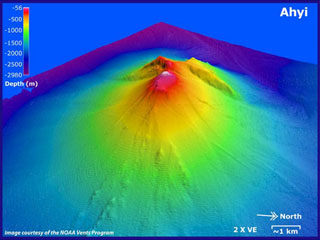Report on Ahyi (United States) — November 1985
Scientific Event Alert Network Bulletin, vol. 10, no. 11 (November 1985)
Managing Editor: Lindsay McClelland.
Ahyi (United States) T-Phases recorded in Tahiti may be from this site
Please cite this report as:
Global Volcanism Program, 1985. Report on Ahyi (United States) (McClelland, L., ed.). Scientific Event Alert Network Bulletin, 10:11. Smithsonian Institution. https://doi.org/10.5479/si.GVP.SEAN198511-284141
Ahyi
United States
20.42°N, 145.03°E; summit elev. -75 m
All times are local (unless otherwise noted)
Between 2 August and 5 September, 109 T-phase events originating in the NW Pacific were received by a high-gain station at Rangiroa, Tahiti. J.M. Talandier notes that their characteristics are typical of submarine volcanic eruptions, being of shallow (ocean) depth; the timing of the events coincides with the presence of a zone of discolored water.... However, a precise origin cannot be determined because the events were of weak amplitude and recorded by only one station.
[Report reviewed and attributed to Ahyi in 2023.]
Geological Summary. Ahyi seamount is a large conical submarine volcano that rises to within 75 m of the ocean surface ~18 km SE of the island of Farallon de Pajaros in the northern Marianas. Water discoloration has been observed there, and in 1979 the crew of a fishing boat felt shocks over the summit area, followed by upwelling of sulfur-bearing water. On 24-25 April 2001 an explosive eruption was detected seismically by a station on Rangiroa Atoll, Tuamotu Archipelago. The event was well constrained (+/- 15 km) at a location near the southern base of Ahyi. An eruption in April-May 2014 was detected by NOAA divers, hydroacoustic sensors, and seismic stations.
Information Contacts: J. Talandier, Lab. de Geophysique, Tahiti.

